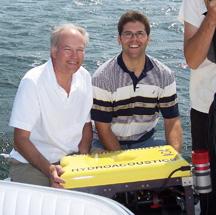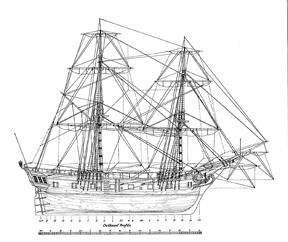Jon Paul’s Maritime Diaries
- Share
- Tweet
- Pin
- Share

Jim Kennard, left, and Dan Scoville, right, along with the Hydroacoustics ROV used in the documentation of the site.
After resting on the bottom for 228 years, the intact British Warship HMS Ontario has been found by shipwreck hunters. On May 24, explorers Jim Kennard and Dan Scoville located the Revolutionary War ship after a three-year search. The find is considered by leading Great Lakes historians as the most significant and historical shipwreck find in the Great Lakes, leaving only the fabled La Salle’s Griffin, lost in 1679, which has not been found, to be older and more historic. The brig HMS Ontario was lost in a storm October 31, 1780 taking 100-plus souls to a watery grave.
Jim and Dan located the wreck on May 24, but then due to weather had to wait until June 8 to send a Remote Operated Vehicle (ROV) down 500 feet to do video documentation. The ROV which has three digital cameras – two black and white and one color – made the 80-minute dive to the wreck site and found both masts still standing upright 70 feet above the hull with the crow’s nest on each mast still in position. The ship lays on the bottom at a 45-degree list to port, fully intact. The bow supports part of the bowsprit and just underneath is an elaborately carved scroll figurehead. One anchor is still supported in its original position, while the other has fallen to the bottom. The two bow chaser cannons are there but have broken from their original fastenings.
Going aft, the standing rigging that supports the masts are still attached to the side of the vessel, including deadeyes and chainplates, less the lines that once were attached to the masts. The stern of the vessel, including the quarter galleries (which are like balconies with windows) located in the officer’s quarters, made positive identification that this was the HMS Ontario. Glass windows in the galleries and stern still have some window panes intact – just another example of the excellent preservation of the wreck. The ships tiller rests on one of the small cannons that were mounted near the stern of the ship. Fallen deadeyes, pulleys and blocks lay strewn about the deck where they fell when lines for the rigging rotted away. Belaying pins still fill the racks they have occupied since October 31, 1780. The hatch covers and skylights are gone, having probably blown off during the sinking of the ship, leaving openings to the lower deck. The ROV, however, could not penetrate the hull due to the silt which was deposited over the years of submersion.
The ship was located with high-tech side scan sonar that Jim Kennard, an electrical engineer, had helped design when he worked for Klein Electronics Company, who designs and builds sophisticated sonar equipment for commercial and military use. Jim has been diving and exploring Great Lakes shipwrecks since 1970 and has found over 200 wrecks from Lake Ontario to the Mississippi River. In 1983 he found a unique horse-powered ferryboat in Lake Champlain that was featured in the October 1989 National Geographic magazine. Jim initially looked for the Ontario in 1973 but gave up two years later because at the time there was no sophisticated location equipment, like Loran C or GPS. This made it nearly impossible to chart areas already covered in the search and get an exact position once the target was found.
Dan Scoville joined Jim six years ago and brought his expertise in technical diving. Dan is trained in the use of mixed gas diving that uses mixtures of oxygen, helium, and nitrogen to dive depths of over 300 feet. This was very useful, for the new wrecks they were finding were in deeper water than sport diving allowed. Dan led the development of an underwater Remote Operated Vehicle with a team of college seniors from the Rochester Institute of Technology. Since then he has used his ROV to explore shipwrecks in Lake Ontario and to locate the bodies of three hunters from a lost Seabee Republic aircraft in Lac Simon, Quebec. He is currently the project manager and electrical engineer for the Remote Operated Vehicle product line at HydroAcoustics, Inc. With Jim’s expertise in side scan sonar and search experience and Dan’s deep water diving and ROV technology, they make an incredibly successful underwater search team.
Joining the team also is Roland Stevens, a retired architect and working artist who has been a sailor for many years and has a love for the sea that is reflected in his seascape watercolor paintings. Roland has painted some of the team’s newly discovered Lake Ontario shipwrecks, depicting them in the storms that sank them and as they lay on the bottom. The book Legend of the Lake, written by author Arthur Britton Smith in 1997, chronicles the history of the HMS Ontario and provides an excellent treatise of the historical conditions between the British and the Americans during this period of time. Arthur Britton Smith commissioned a naval architect in1997 to draw a profile and deck arrangement of the HMS Ontario from historical records. The team used these drawings to compare with the video of the wreck site and was astounded at the accuracy of the drawings.
In a recent telephone interview, Jim said the team has no plans for right now to go back to the wreck of the Ontario and keeping the site’s location a secret is a priority. The wreck is property of Great Britain and they have notified the US Navy Department, who has contacted the British Naval Department. The British Naval Department thanked Jim and Dan for the information and said at this time they have no plans to excavate, raise or survey the wreck but to protect the site and treat it as a war grave. Dan said it was a great discovery and will be hard to top; they have found three or four new wrecks but will wait awhile until all of the excitement of the Ontario has died down to unveil the new wrecks. Right now they are in negotiations with several documentary filmmakers to make a documentary on the story of the HMS Ontario and a deal with a film maker is very close right now. Part II of the HMS Ontario will undertake the history and legends that surround the British Warship.

